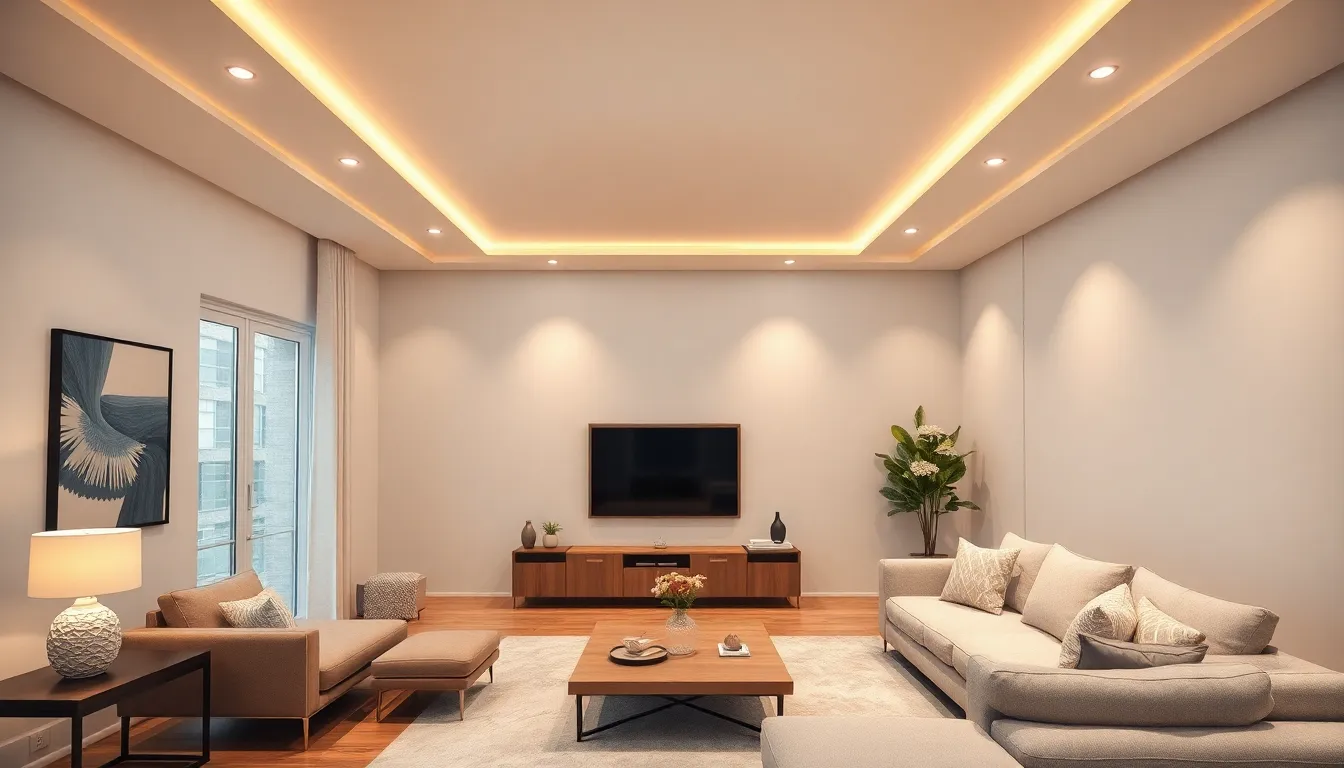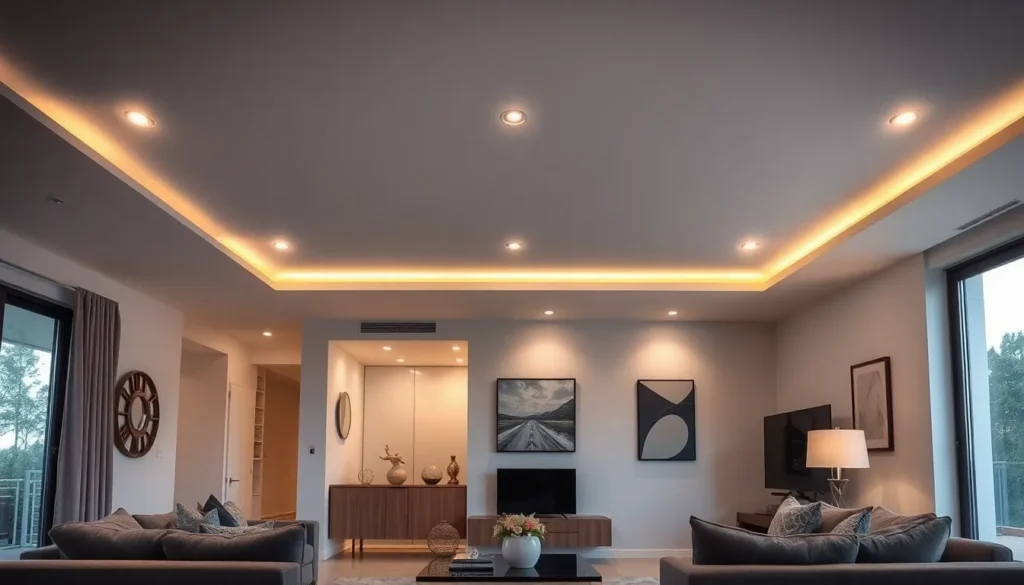Table of Contents
ToggleRecessed lighting might just be the unsung hero of home design. Imagine your space bathed in soft, inviting light without those clunky fixtures stealing the show. It’s like the ninja of illumination—stealthy yet powerful. Whether you’re trying to create a cozy atmosphere for movie night or highlight your grandma’s questionable art collection, recessed lighting does it all without breaking a sweat.
But wait—don’t let its subtlety fool you. This lighting choice packs a punch when it comes to style and functionality. With the right placement, it can transform any room from drab to fab faster than you can say “let there be light.” So, if you’re ready to upgrade your lighting game and perhaps finally get rid of that outdated ceiling fan, recessed lighting might just be your new best friend.
Overview of Recessed Lighting
Recessed lighting features fixtures installed into the ceiling to create a clean, streamlined look. This design aspect eliminates bulky light sources, resulting in a more open and spacious feel. Additionally, the placement of recessed lights allows for versatile illumination options.
Options for recessed lighting include different sizes, shapes, and light types. Common bulb types include LED, incandescent, and fluorescent. Choosing the right bulb affects energy efficiency and ambiance. LEDs offer high efficiency, while incandescent provides warmth.
Placement plays a crucial role in achieving desired effects. Strategically positioned recessed lights can highlight artwork or architectural features. It’s essential to consider spacing; for example, spacing fixtures 4 to 6 feet apart generally provides even lighting.
Homeowners can customize intensity using dimmers. Dimming options enhance flexibility for various moods and activities. Installing a dimmer switch allows for quick adjustments from bright task lighting to soft ambiance.
In residential spaces, recessed lighting serves multiple functions. It can illuminate kitchens for cooking, brighten living rooms for gatherings, or create a relaxing atmosphere in bedrooms. This adaptability enhances overall home design aesthetics while fulfilling practical lighting needs.
The installation of recessed lights requires planning. Understanding the ceiling structure and choosing appropriate trim styles is vital. Consulting with professionals can ensure proper installation and optimal performance.
Considering these elements leads to informed decisions about recessed lighting. This lighting option not only elevates interiors but also promotes functionality and energy efficiency, making it a popular choice for modern homes.
Benefits of Recessed Lighting

Recessed lighting offers several advantages that enhance home design and functionality. This lighting approach caters to various needs and preferences, making it a popular choice among homeowners.
Aesthetic Appeal
A sleek appearance characterizes recessed lighting, providing an unobtrusive solution for illuminating spaces. Minimalistic design enhances a room’s overall decor while drawing attention to architectural features. Homeowners appreciate the ability to showcase artwork, furniture, or other focal points without clutter from traditional fixtures. Versatile styles accommodate various interior themes, from contemporary to classic, ensuring seamless integration. Soft, ambient light promotes a warm and inviting atmosphere, making spaces more enjoyable for residents and guests.
Space-Saving Design
Recessed lighting maximizes vertical space by eliminating bulky fixtures that hang from ceilings. This flush installation enables a more open and airy feel in rooms, particularly beneficial for smaller areas. Homeowners leverage this design technique to create a clean, streamlined look, contributing to efficient space utilization. Effective placement allows for even illumination without sacrificing headroom, which enhances comfort and accessibility. Ceiling height remains visually unencumbered, promoting a sense of spaciousness throughout the home.
Types of Recessed Lighting
Recessed lighting comes in various types, tailored to specific needs and settings. Understanding these types enhances choices for effective and stylish illumination.
New Construction vs. Remodel Can Lights
New construction can lights integrate seamlessly during initial building phases. They install directly into the ceiling joists, allowing for meticulous planning of layout and spacing. Remodel can lights serve existing spaces and attach to ceiling structures without extensive alterations. They often use retrofit kits, providing flexibility for homeowners looking to upgrade their lighting without significant demolition.
Shower and Outdoor Recessed Lighting
Shower recessed lighting requires fixtures designed for damp locations, ensuring safety and durability. These fixtures use wet-rated options, preventing moisture damage. Outdoor recessed lighting enhances exterior spaces with soft, even illumination. Suitable for patios, decks, and pathways, these fixtures prioritize weather resistance and energy efficiency, providing both functionality and aesthetic appeal for outdoor areas.
Installation Process
Recessed lighting installation combines essential tools and straightforward steps. Knowing these aspects ensures a smooth process.
Tools Required for Installation
Electricians often require specific tools for recessed lighting installation. Common tools include a drill for creating openings, a stud finder to locate ceiling joists, and a measuring tape for accurate placement. Wire strippers help prepare electrical wires, while a voltage tester ensures safety by checking for live wires. Additionally, a level guarantees proper alignment of fixtures. These tools play crucial roles in the installation process, enabling efficient and precise work.
Steps to Install Recessed Lighting
Electricians follow several essential steps to install recessed lighting correctly. First, determining the fixture locations is vital for achieving even illumination. Next, they prepare the ceiling by cutting holes using the appropriate saw, ensuring a snug fit for the cans. Afterward, it’s crucial to run electrical wiring from a power source to each light. Connecting the wires to the fixtures follows, utilizing wire nuts for secure connections. Lastly, securing the cans in place and attaching the trim allows for a polished finish. Following these steps results in a successful and efficient installation of recessed lighting.
Energy Efficiency and Costs
Recessed lighting offers notable energy efficiency and cost benefits, especially when compared to traditional lighting solutions.
LED vs. Traditional Bulbs
LED bulbs stand out for their energy savings, using up to 75% less energy than incandescent bulbs. They boast a lifespan of approximately 25,000 hours, providing extended illumination before replacement is necessary. In contrast, incandescent bulbs typically last only about 1,000 hours, resulting in more frequent replacements and higher overall costs. Many homeowners appreciate that LED options emit less heat, contributing to additional energy savings and improved safety. Choosing LED recessed lighting not only enhances aesthetic appeal but also significantly reduces energy-related expenditures.
Long-Term Savings
Investing in recessed lighting with LED bulbs results in substantial long-term savings. Lower energy consumption translates into reduced utility bills, often saving households hundreds of dollars over a year. Installation might require an upfront investment but the financial returns from energy efficiency justify the expense. Many find that rebates and incentives for energy-efficient lighting further reduce the initial cost. Over time, these savings provide a clear financial advantage, making recessed lighting an intelligent choice for budget-conscious homeowners.
Recessed lighting stands out as an excellent choice for modern home design. Its ability to blend seamlessly into ceilings enhances aesthetics while providing effective illumination. Homeowners can enjoy the flexibility of adjusting light levels with dimmers and choosing from various bulb types for energy efficiency.
The installation process, while requiring careful planning, leads to long-term benefits that extend beyond mere aesthetics. With its space-saving design and versatility, recessed lighting not only enhances the ambiance of any room but also contributes to significant energy savings. Embracing this lighting solution can transform spaces into inviting environments that cater to both functionality and style.




